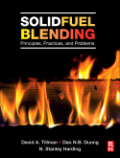
Solid fuel blending: principles, practices, and problems
Tillman, David
Duong, Dao
Harding, N. Stanley
Create affordable solid fuel blends that will burn efficiently while reducingthe carbon footprint. Solid Fuel Blending Handbook: Principles, Practices, and Problems describes a new generation of solid fuel blending processes. The book includes discussions on such topics as flame structure and combustion performance, boiler efficiency, capacity as influenced by flue gas volume and temperature, slagging and fouling, corrosion, and emissions. Attention is given to the major types of combustion systems including stokers, pulverized coal, cyclone, and fluidized bed boilers. Specific topics considered include chlorine inone or more coals, alkali metals (e.g., K, Na) and alkali earth elements, andrelated topics. Coals of consideration include Appalachian, Interior Province, and Western bituminous coals; Powder River Basin (PRB) and other subbituminous coals; Fort Union and Gulf Coast lignites, and many of the off-shore coals (e.g., Adaro coal, an Indonesian subbituminous coal with very low sulfur; other off-shore coals from Germany, Poland, Australia, South Africa, Columbia, andmore). Interactions between fuels and the potential for blends to be different from the parent coals will be a critical focus of this of the book. One stopsource to solid fuel types and blending processes .Evaluate combustion systems and calculate their efficiency .Recognize the interactions between fuels andtheir potential energy out put .Be aware of the Environmental Aspects of FuelBlending
- ISBN: 978-0-12-380932-2
- Editorial: Butterworth-Heinemann
- Encuadernacion: Cartoné
- Páginas: 352
- Fecha Publicación: 27/04/2012
- Nº Volúmenes: 1
- Idioma: Inglés
